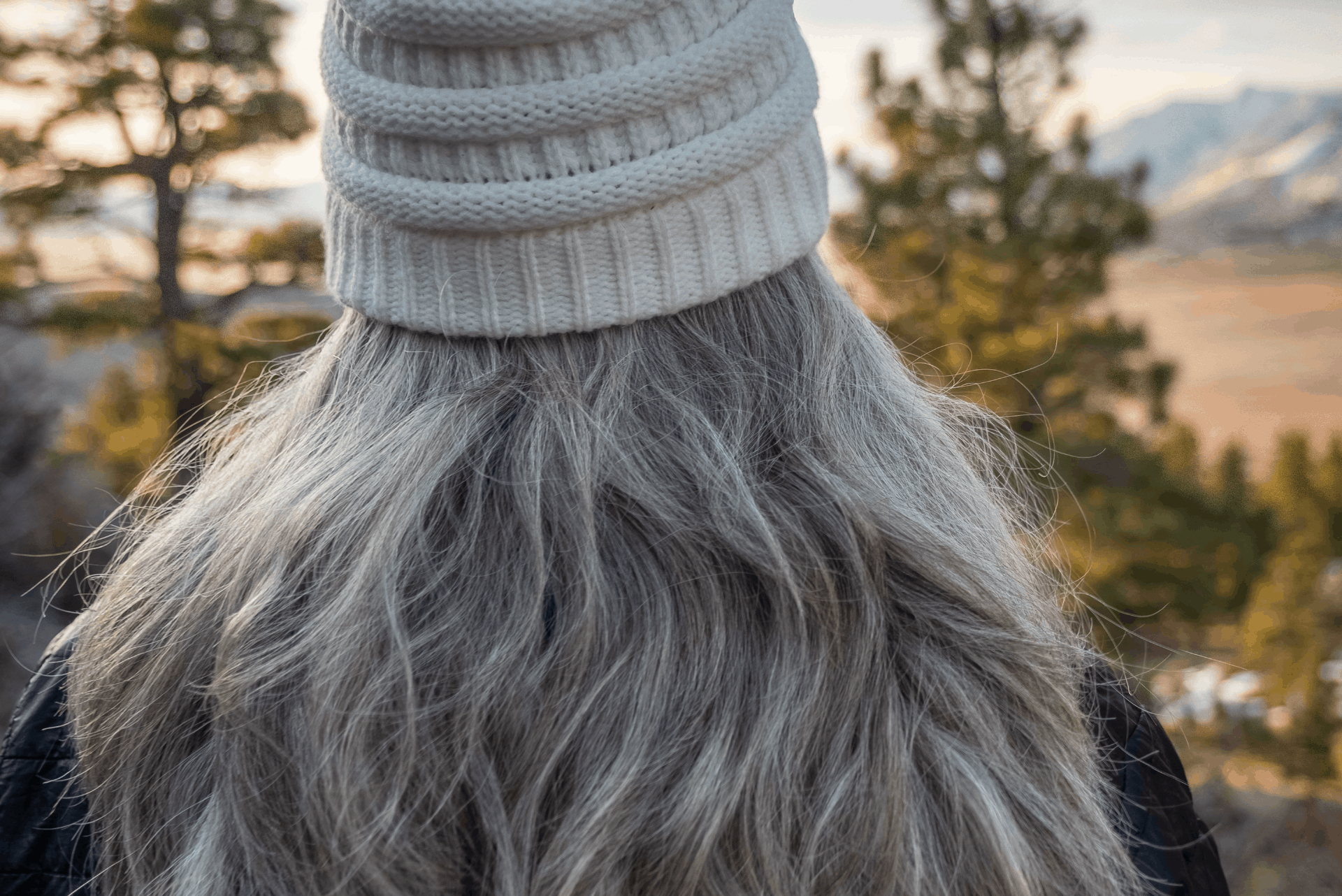Some people see gray hair as a sign they are growing older and wiser. Others just see it as an unwelcome reminder of the years passing by. In either case, gray hairs are bound to happen to everybody at some point, and besides wondering why does hair go gray or what causes grey hair, you can also learn proper gray hair care. If you just want to let go and embrace gray hair, you may want to learn how to transition to gray hair or how to cover it naturally so it’s less visible.
Whether you want to be a silver fox, get a cute pixie, or dye those stubborn grays back to their original color, it pays to know how to take care of grey hair or make it go away.
Table of Contents
What Causes Gray Hair?
Hair goes gray when the pigment cells producing melanin in your hair follicles decide to stop working. Once the follicle produces new hair after that point, that new hair will be gray, silver, or even white. Stress can make hair fall off, which means that if your hair follicle had stopped producing melanin at that point, it can feel like the regrowth is suddenly grey.
Most people get their first greys in their early to late 30s, but genetics may dictate that you get them as early as your early 20s. Look at your parents, if they went grey early, chances are you will too.
Keep in mind that once a hair follicle starts growing grey hair, it won’t go back to producing melanin. So removing your white hairs with a pair of tweezers won’t make them go away. In fact, it can harm the follicle and stop new hair from growing entirely, so don’t pull your grays out. On the bright side, pulling gray hair won’t make two appear in its place.
Transitioning to Gray Hair
If you have been dying your hair for a long time, you’re probably wondering how to transition to gray hair. Chopping off all your hair into a pixie and starting over is an option, but it’s a bit too radical for most people.
Letting your dye job grow out is another way of transitioning to gray hair, but it may not look great, particularly if you usually dye a darker color.
So what is the best way to transition to gray hair gracefully?
Dyeing Your Hair Gray
A less radical option is taking the plunge and coloring your hair gray, using highlights to make your overall hair color look closer to your undyed gray roots. This process is similar to a color correction, where a hairdresser would fix hair color gone wrong.
But in this case, the goal is to blend your natural color into your grays so it looks like you got gray hair all over, as opposed to just a few inches of regrowth. This way there is no demarcation line, no ‘skunk stripe.’
If you are thinking of transitioning to gray hair by dyeing your hair gray, keep in mind that you’ll need some regrowth for the hairdresser to work with. Stop coloring your roots as soon as you decide, and have a consultation to see how quickly you can start the process.
For example, if your gray pattern is salt and pepper, your hairdresser could blend ashy, grey highlights into a brown base similar to your natural hair color. Your hair will still be dyed, but as your naturally gray hair grows less and less highlighting will be required. And it will grow beautifully, instead of with obvious roots, so you shouldn’t need to visit your hairdresser more than once every few months.
It can take several visits to the hairdresser over a period of several months until your hair is growing fully gray. Gray highlights can turn brassy or yellow, so you should include a great purple shampoo in your routine.
This is an example of what can be accomplished in just a year.
View this post on Instagram
Dyeing your hair gray yourself is not impossible, but the right placement of the highlights is key, so having a hairdresser or somebody to help is very important. Otherwise, you may end up with a result that still looks highlighted instead of naturally going gray.
A color glaze to tone yellow away and some platinum highlights to brighten up the face can make transitioning to gray hair modern and stylish.
Cutting Off Your Hair
Transitioning to gray hair by cutting it into a pixie (or shorter) is the quickest way to go grey. It is also quite a strong change in both style and color, particularly if you usually have long dark hair. A silver pixie can look really classy and modern, but you may find people don’t recognize you for the first few weeks!
The texture of gray hair is often different from what you are used to. It can feel more coarse and difficult to style, but it will hold a curl or wave better. Often you’ll find that your hair dries quicker and holds texture better, which is great. But you’ll also need to moisturize more and wash it less often, even if you are styling a pixie and washing hair days are no longer time-consuming.
Bleaching Gray Hair
If you are a natural blonde you may be able to just get on with letting your hair grow and the gray hairs will look like highlights. A purple shampoo used regularly will keep your grays from looking too yellow, and most people choose to get some cool-toned highlights to help the gray hair blend beautifully.
If you are transitioning to grey hair from dyed hair an overall bleach to lighten your base can make the contrast less start. This often makes transitioning to gray hair much easier, as you won’t be fighting a visible gray stripe on your head.
Bleaching gray hair so it blends better with a blonde base can be a good solution to how to transition to gray hair without having to cut it all off. However, this is not without risks: bleach can damage your hair and unless you use Olaplex or a similar bond rebuilder. As you grow your hair the bleached ends may start looking wiry and unruly, and you may find yourself cutting your hair shorter anyway.
Growing Out Gray Hair
If you want to stop dyeing your hair cold turkey, but don’t fancy a new hairstyle, growing out gray hair can also be done. Depending on how much contrast there is between your natural gray hair and your base color, the grow-out will be more or less obvious.
Somebody who is naturally ashy blonde will find growing out gray hair easy, as it will just look like highlights. A dark brunette whose grays grow in stripes may find the process less appealing.
There are some ways to grow long hair that can be applied to growing out gray hair as quickly as possible. A good diet and hair care products that prevent damage will go a long way to encourage natural hair growth and reduce broken strands. Keep in mind that your gray hairs may have a different texture than the rest of the hair, so give your hair plenty of moisture to avoid frizz.
A purple shampoo for gray hair will keep your gray hair shine naturally instead of yellow and will give your hair a cooler tone overall.
How to Cover Gray Hair Naturally
Transitioning to gray hair is an option, but so is covering your grays and keeping your usual darker mane looking less gray. If you are looking for a natural hair dye for grey hair, you should consider henna. Henna hair dye for gray hair is quite the permanent solution, as removing henna is difficult. However, it offers a multi-tonal, rich color that blends greys and conditions your hair.
Using henna to cover your gray hairs is a bit of a process, but the results can be amazing. It is, for many, the best natural hair dye for grey hair. Just keep in mind that if you want to transition to gray afterward, you may need to cut off your hair into a pixie.
If the permanency of Henna worries you, there are other dyes in the market that can be used to naturally return your hair to its original hair color. They do this by either depositing pigments or using natural botanical ingredients such as coffee or tea extracts to blend gray hairs right in.
If you use permanent hair color, you will need to re-do your roots every few weeks to make sure the dreaded skunk stripe doesn’t appear. In order to reduce the maintenance, it’s always better to go with a color that is just slightly lighter than your natural hair color and with the same undertones.
Rosemary tea is another possible solution to prevent gray hairs and even return them to their natural color when used as a soak or rinse. If you don’t have a lot of gray hair yet and are wondering how to cover gray hair naturally, you can’t go wrong trying it. Other natural grey hair remedies to try are:
- Onion Juice
- Black tea rinse
- Curry leaves and oil (boiled until they turn black and used 2-3 times a week)
You can’t really reverse gray hair permanently, but at least you can delay its appearance.
Dyeing Gray Hair Blonde
Many people transitioning to gray hair choose to dye their hair blonde to help the greys blend in. Dying gray hair blonde can be challenging as gray hair doesn’t hold color the same way regular hair does.
If you want to cover gray hair by lightening your mane, start by making sure your hair is in tip-top condition. A weekly deep conditioning mask is a must to prepare your hair for the lightening process.
If your hair is less than 25% gray, getting blonde highlights will be less damaging to your hair but still blend grays well. Use at least 3 different tones, as a combination of highlights and lowlights will blend better with your silver hair. When having it done at the hairdresser, ask for balayage as it will look more natural.
If you are dyeing gray hair blonde choose a permanent hair dye instead of a semi-permanent one, and go for a color one level lighter than your base color. You can also use high lift blonde dyes to achieve blonde hair without bleach.
Bleaching gray hair can be a challenge as the bleach will take different to gray and non-gray hair, but it’s the only effective way to lift dark hair to blonde.
How to Care for Gray Hair
Gray hair can feel different from your regular hair, and while nobody knows exactly why, it’s a fact that gray hair can have a different texture. In general, it will feel thicker and be able to hold a curl better, and you may enjoy the extra texture. However, in order to keep gray hair soft and avoid a dirty look, there are a couple of things to keep in mind.
Purple Shampoo for Gray Hair
If you are a bottle blonde, you’ll be familiar with using purple shampoo to avoid yellowing hair. This also applies to naturally occurring greys, which can oxidize to an unflattering dirty yellow color very easily. The best way to avoid this is by investing in a good purple shampoo for grey hair and using it at least once a week. You may need to use it more or less often, depending on where you live, the mineral content of your water, and how much sun exposure you get.
If your zone has hard water choose a good shampoo for hard water and double cleanse with a purple shampoo afterward to remove any mineral buildup that could be yellowing your silver strands.
If your hair feels dryer than usual, a cool blonde conditioner will keep it bright and manageable. A weekly deep conditioning mask is a must for most people transitioning to gray hair, as it helps blend the different hair textures.
Styling Gray Hair
Most people who are transitioning to gray hair are surprised at how much thicker and textured their hair feels. Avoid heavy creams and oils that will weigh down your hair, and just go with a shine serum to get those greys to sparkle.
A professional glossing treatment (or at-home one, if you are adventurous) is particularly dramatic on silver-haired ladies. It will make your hair smoother, and enhance its natural brilliance.
What’s Next
See the best shampoos for gray hair here!
0





